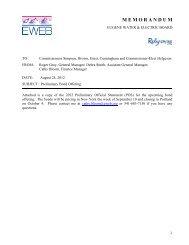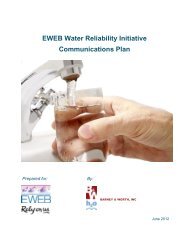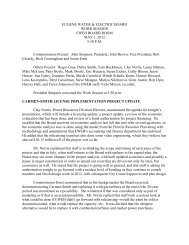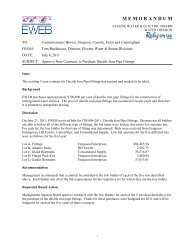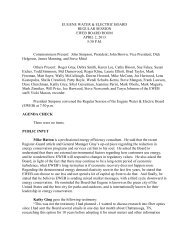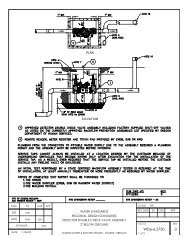Preparing for the NEXT CENTURY - Eugene Water & Electric Board
Preparing for the NEXT CENTURY - Eugene Water & Electric Board
Preparing for the NEXT CENTURY - Eugene Water & Electric Board
Create successful ePaper yourself
Turn your PDF publications into a flip-book with our unique Google optimized e-Paper software.
6 EWEB: PREPARING FOR THE <strong>NEXT</strong> <strong>CENTURY</strong><br />
Thirty years of energy conservation<br />
No utility in <strong>the</strong> Northwest has done more to help its customers use less energy over <strong>the</strong> past<br />
three decades. EWEB customers have saved a cumulative 52 average megawatts over <strong>the</strong><br />
past 30 years. That’s more energy than is generated annually by all of EWEB’s hydroelectric<br />
projects in Oregon. How did it all begin The following is a retrospective of how <strong>Eugene</strong> citizens and<br />
<strong>the</strong>ir publicly owned utility came to view energy conservation as a legitimate alternative to energy<br />
generation.<br />
The “big bang” that ignited <strong>the</strong> modern<br />
era of energy conservation was <strong>the</strong> 1973<br />
Arab oil embargo against <strong>the</strong> U.S., which<br />
resulted in long lines at gasoline stations<br />
and heating oil shortages.<br />
But <strong>the</strong> embargo’s biggest, lasting effect<br />
was on <strong>the</strong> mind-set of most Americans,<br />
who <strong>for</strong> <strong>the</strong> first time realized that our<br />
traditional energy resources are not<br />
limitless.<br />
At <strong>the</strong> time, most electric utilities still<br />
were promoting <strong>the</strong> 1950s <strong>the</strong>me of “living<br />
better electrically.” New appliances and all<br />
things electrical proliferated at a time when<br />
“Redi-Kilowatt,” <strong>the</strong> animated electricity<br />
icon, promised us: “Inside and out, your<br />
home will have all <strong>the</strong> magic that electricity<br />
can per<strong>for</strong>m – plus ample horsepower <strong>for</strong><br />
future conveniences that electrical research<br />
is sure to provide.”<br />
Things were not much different in<br />
<strong>Eugene</strong> in <strong>the</strong> early 1970s. When upstart<br />
EWEB Commissioner John Reynolds,<br />
a University of Oregon architecture<br />
professor, made a motion to appoint a<br />
citizens’ advisory committee on energy<br />
conservation, it died <strong>for</strong> lack of a second by<br />
o<strong>the</strong>r board members.<br />
We needn’t rush into “lowering<br />
<strong>the</strong> standard of living of <strong>the</strong> citizens of<br />
<strong>Eugene</strong>,” countered one board member.<br />
Yet resource planners recognized that<br />
demand <strong>for</strong> electricity would continue to<br />
grow, as new residents, businesses and<br />
industry relocated to <strong>Eugene</strong>. Where would<br />
<strong>the</strong> energy come from<br />
Initially, nuclear power was seen as<br />
<strong>the</strong> answer. But in 1970, <strong>Eugene</strong> voters<br />
approved a four-year moratorium on <strong>the</strong><br />
construction of nuclear power plants in or<br />
near <strong>the</strong> city. Conservation began to emerge<br />
as a viable option.<br />
“The need <strong>for</strong> new resources remained,<br />
and without <strong>the</strong> option of nuclear power,<br />
EWEB commissioners directed staff to<br />
pursue conservation and renewable energy<br />
resources,” says Mat Northway, Manager of<br />
Energy Management Services since 1984.<br />
As a first step, <strong>the</strong> utility established<br />
EWEB’s Conservation Center in 1977 to<br />
help customers identify ways to reduce<br />
electric waste and improve efficiency of<br />
use.<br />
“EWEB’s Conservation Center was <strong>the</strong><br />
very first of its kind in <strong>the</strong> country,” says<br />
Ralph Cavanagh, senior attorney <strong>for</strong> <strong>the</strong><br />
Natural Resources Defense Council who<br />
is considered one of <strong>the</strong> founders of <strong>the</strong><br />
energy conservation movement.<br />
“Unlike most utility boards at that<br />
time, EWEB commissioners had come to<br />
view conservation as an energy resource<br />
opportunity, and <strong>the</strong> <strong>Eugene</strong> community<br />
embraced <strong>the</strong> concept,” adds Northway.<br />
In 1980, Congress approved <strong>the</strong> Pacific<br />
( )<br />
“It is because of<br />
innovators like you that<br />
Oregon is a leader in <strong>the</strong><br />
efficient use of energy.”<br />
– Former Oregon Gov. Victor Atiyeh<br />
Northwest <strong>Electric</strong> Power Planning and<br />
Conservation Act, which directed <strong>the</strong><br />
region to adopt plans to ensure a lowcost,<br />
sustainable electric energy supply<br />
in <strong>the</strong> future. Those plans included <strong>the</strong><br />
development of energy conservation,<br />
renewables and o<strong>the</strong>r resources.<br />
Soon, <strong>the</strong> federal Bonneville Power<br />
Administration began working with<br />
Northwest utilities to implement broadbased<br />
conservation programs. In 1982,<br />
EWEB signed a residential wea<strong>the</strong>rization<br />
contract with <strong>the</strong> federal power-marketing<br />
agency to begin providing rebates to assist<br />
customers in wea<strong>the</strong>rizing <strong>the</strong>ir homes.<br />
“It was becoming increasingly clear that<br />
<strong>the</strong> cheapest potential source of energy was<br />
conservation,” says <strong>for</strong>mer EWEB President<br />
Camilla Pratt.<br />
The new program instantly created a<br />
two-year waiting list to participate in <strong>the</strong><br />
EWEB/Bonneville wea<strong>the</strong>rization initiative.<br />
In September 1983, <strong>the</strong> first month of <strong>the</strong><br />
initiative, EWEB completed over $1 million<br />
in wea<strong>the</strong>rization work, recalls EWEB Key<br />
Accounts Manager Mike Logan.<br />
The program eventually included an<br />
innovative financing method that had never<br />
been done be<strong>for</strong>e. Using its tax-exempt<br />
status as a municipal utility, EWEB sold





